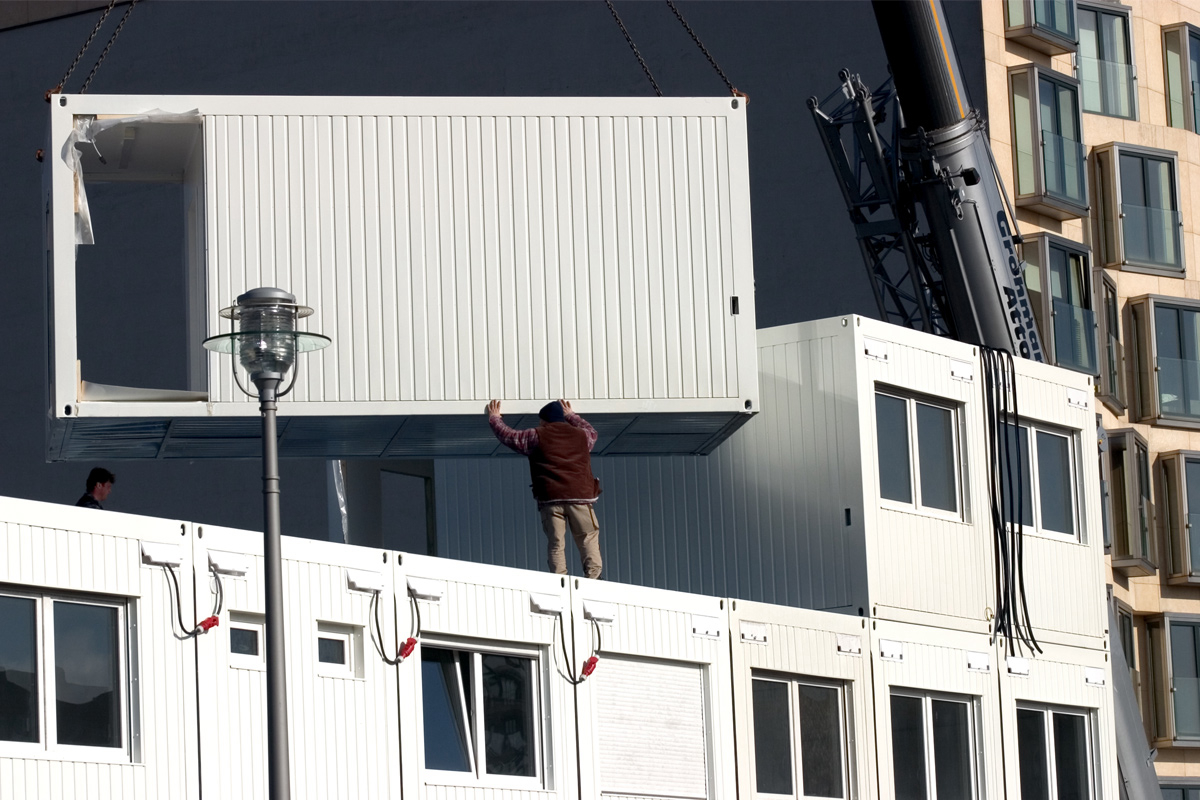How the situation with the handling of construction containers currently looks

Construction sites that last several days frequently rely on construction site containers—whether for materials, office space, or temporary accommodation. These containers come in all colours, shapes and sizes. While standard ISO containers (ISO 668) follow uniform dimensions, construction containers are often non-standard, with varying designs and materials depending on the manufacturer. Unfortunately, a lack of standardisation complicates safe handling on-site.
In many cases, these containers lack designated lifting points or attachment eyes, making secure slinging difficult. Improvised or unsafe lifting methods can result in slippage, leading to load drops, equipment damage, or serious injuries. When containers are lifted from above, workers are often required to climb onto the container to attach or detach the slings—frequently without adequate fall protection. Falls from these heights can result in severe or even life-changing injuries.
It is therefore essential that contractors take appropriate safety measures to protect lifting personnel and ensure compliance with health and safety regulations. On most construction sites, containers are moved using cranes, typically arriving by lorry before being lifted into position. Fully loaded, these containers can weigh several tonnes—posing significant risks if not lifted correctly. Improper slinging not only endangers the slinger but can also damage the container.
For safe, efficient and compliant container lifting on construction sites, it's crucial to use properly designed lifting points, appropriate slinging equipment, and trained personnel to avoid accidents and delays.
Special solution for handling construction containers for a customer

A customer in the construction industry required lightweight, non-damaging lifting equipment for transporting painted containers. The issue: the previously used steel sling chains were causing scratches and surface damage to the containers. As part of a brand refresh, the company had decided to exclusively use yellow containers featuring its logo. To maintain the containers’ clean appearance and avoid premature wear, the customer sought a more gentle lifting solution.
The answer came in the form of Green Pin Tycan® textile sling chains from Van Beest. These high-performance textile chains were provided for a long-term test phase. Over the course of three to four months, several low-loader drivers put the slings to the test during intensive daily operations.
Driver feedback highlighted several advantages:
-
The individual chain strands could be easily shortened, allowing for perfect container balance.
-
The textile sling functioned just like a conventional 4-leg sling chain.
-
Attachment was possible at the base of the container, eliminating the need to climb on top—enhancing worker safety.
-
Despite their light weight, the slings offered exceptionally high load-bearing capacity.
Following successful trials, the customer opted for a customised textile sling chain configuration, which included:
-
Shackles instead of shortening hooks
-
Two protective sleeves per strand for extra surface protection
This case clearly demonstrates how textile sling chains provide an ideal solution for damage-free container lifting, improving both safety and efficiency on construction sites.
The Green Pin Tycan textile sling chain offers the user many advantages

- Up to 8 times lighter than a comparable steel chain
- Made from high-strength Dyneema® fibre
- Multi-layer Dyneema® webbing arranged in a Möbius loop, stitched on both sides
- Improves the working environment in terms of safety and ergonomics
- Easy handling
- Uncomplicated shortening using shortening hooks
- Increased protection for people and materials
- Environmentally friendly manufacturing process
- Extremely abrasion-resistant
- Reduced risk of load damage
- Noise-reducing
- UV-resistant
- Resistant to most chemicals and dirt
- Non-electrically conductive
- Water-resistant and floatable
- DNV-GL certified
- Temperature application range: -40°C to +70°
FAQ: Handling of construction containers
Are the textile chains more expensive than conventional steel chains?
Yes, textile chains are slightly more expensive than conventional steel chains. However, the many advantages of textile chains compared to classic steel chains largely make up for the price difference.
Are textile chains just as safe as classic steel chains?
Yes, the textile chains are just as safe. With a link size of 13 x 30 mm, the textile chain has a load capacity of 6.8 tonnes.
Are there several variants of the textile sling chains?
The textile chains are available in 1, 2 and 4-strand versions, each in the non-shortenable and shortenable versions with shortening hooks. The textile chains are also available as lashing chains.
